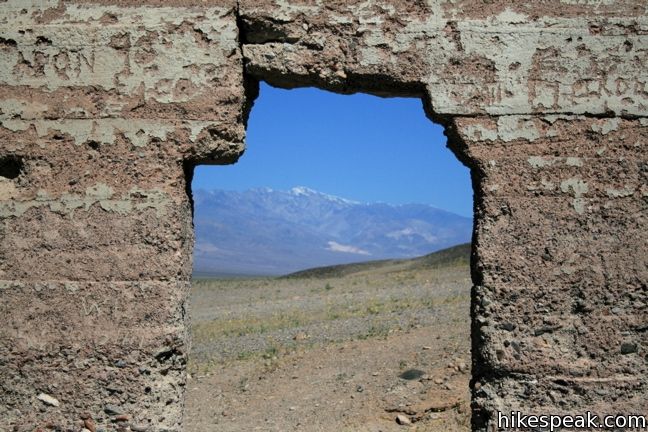
The Ashford Mill ruins are visible to those driving up route 178 to Badwater Basin and Furnace Creek in Death Valley National Park. The ruins rest on the valley floor at an elevation of 121 feet below sea level. They serve as a picturesque example of the rigors of life in this harsh desert.
In 1914, Ashford Mill was built to process gold from the Ashford Mine, located in the mountains to the east. Like many desert mines, Ashford went through several owners with long breaks in production. Today, the ruin of Ashford Mill can be explored in under ten minutes. The site also holds the distinction of being the southernmost bathroom in Death Valley National Park, so it may be worth stopping for other reasons.
Those with high clearance vehicles may also explore Ashford Mine. A dirt road directly across from Ashford Mill heads east for three miles. From here it is a 1.5-mile hike to the old mine.

To get to Ashford Mill: The ruins are located just off Badwater Road 25 miles north of the southern park entrance and 27 miles south of Badwater Basin. From Furnace Creek, drive 44.5 miles south on Badwater Road and turn west at the sign into the parking area for Ashford Mill.
Ashford Mill address: Badwater Road, Death Valley National Park, Death Valley, CA 92328
Ashford Mill coordinates: 35.9209, -116.6813 (35° 55′ 15″N 116° 40′ 52.5″W)
Use the map below to view the attraction and get directions:
Or view California Desert trails and campgrounds in a larger map
 | Badwater Basin This is the lowest place in North America — a required stop for first time visitors to Death Valley. |
 | Dante’s View This towering overlook above Badwater Basin offers panoramic views of Death Valley. |
 | Artist’s Drive This 9-mile drive crosses a sloping mountainside composed of vibrant soil colored by rich metals. |
 | Harmony Borax The ¼ mile walk around the Harmony Borax plant offers a window into the mining past of Death Valley. |
 | Zabriskie Point This easy-to-reach overlook offers a stunning panorama of the badlands near Furnace Creek. |
 | Charcoal Kilns These conical constructions converted lumber to charcoal for area miners from 1879 to 1882. |
 | Death Valley Explore more destinations in Death Valley National Park. |
 | Death Valley CampgroundsNine campgrounds are spread throughout this large park to facilitate your visit. |














